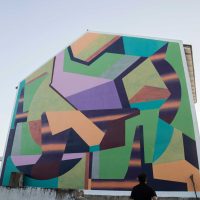Christian Riffel, born in Buenos Aires in 1982. He is a visual artist and muralist. Riffel’s work is influenced by his design studies and by his work on the street in the late ’90s.
Towards 2010 he turns to abstraction and geometry. From his large-format painting in public space, to iron sculptures, small-format paintings and supports, one can analyze his work influenced by urban matter and the intersection of the abstract art tradition.
The disruptive in composition, tension and color are the subject of study. The multiple ways of representing geometry is predominant in his work. He is interested in experimenting with different pictorial systems, which generate crosses where Riffel questions a new spatiality.
Christian Riffel Statement
My area of work is delimited by the intersection of the tradition of geometric abstract art and urban matter. I practice my painting when I move down the street, the visible that exists outside of me, in the urban space, is objectively perceived from my condition as a panopticon subject. The public space is presented as a field cut by the city, its architecture, its lines section the horizon. What wakes up with the setting of the sun, as the shadows are projected and vanish, become more complex and reveal new forms.
I take this experience to the visual arts, I build a poetics of geometry and space. An illusory, spatial, disruptive geometry, something Kitsch. That is generated by circulating in a system of relationships. One is the manipulated color and the specificity of a cosmic rhythm that generates the water, the other is the saturated color and the dimensional. I am interested in the linear rupture in the geometric and experiencing a collective system, where the crossings generate a place of inflection that leads me to think of a between, a spatial perception, where there is a time but also a break where it is possible to reside.
I draw lines that deviate from mathematical formulas that capture the strangeness and mystery. I tend more to think of things as lines that have to be separated and mixed. There are lines that form contours, there are others that do not, that give privilege to the counterform. There are lines that modulate the shape, a shape that changes in each piece to come closer to the intuitive formal.
I am interested in the analysis of the concrete artists from the River Plate, Russian constructivism and the North American shaped canvas of the 60’s.
In my installation work I appropriate the immaterial space through devices, static or dynamic, that aim to decentralize the traditional object. I use mirrors to redirect the light in the surrounding environment in order to disrupt the space, with reflections that generate an immaterial space, with the aim of a singular experience. The singular is the only thing that makes the encounter possible.
I analyze the photogeometries of Gerarlo De Barros and German Lorca, the research on light by Maholy Nagy, and the work of Nathan Lerner and Julio Le Parc.




